Most people train the triceps in one of two ways.
Either they pummel their “tris” with tons of triceps isolation exercises each week, or they focus on doing plenty of pressing and let triceps development take care of itself.
Is one of these approaches superior, though?
Do you need to isolate your triceps to maximize growth, or is bench pressing enough to build impressive upper arms?
Here’s what science says.
Triceps Anatomy
The triceps brachii, more commonly referred to as the triceps, is a three-headed muscle located on the back of the upper arm, between the shoulder and elbow.
Its principle function is elbow extension (straightening your elbow to move your hand away from your shoulder), though it’s also involved in shoulder extension (moving your arm from by your side to behind your body) and shoulder adduction (moving your arm across the midline of your body).
Here’s how the triceps looks:
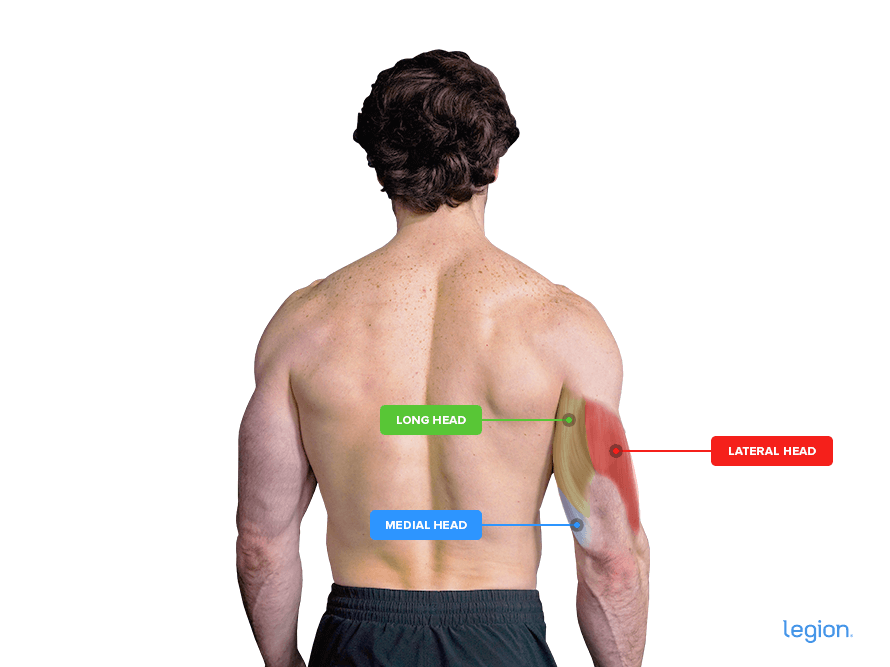
Many people train their triceps with isolation exercises, including the triceps pushdown, overhead triceps extension, and “skullcrusher,” because these exercises allow you to extend your elbow against external resistance. This makes them ideal for developing triceps size and strength.
However, compound pressing exercises, such as the bench press, incline bench press, and dumbbell bench press, also involve elbow extension. As such, some people believe these are the only exercises you need to develop your triceps.
That is, they think you can omit all triceps isolation exercises from your program, provided you include plenty of bench press variations. This is significant because removing triceps isolation exercises from your program could significantly decrease the length of some of your workouts or enable you to ditch your triceps workout each week entirely.
It’s a compelling approach, but is bench pressing really enough to train your triceps?
Does Bench Press Work Your Triceps?
To find out, scientists at Paulista University put 43 men who hadn’t done any weightlifting for at least 6 months into 4 groups:
- A group that only did the bench press.
- A group that only did the skullcrusher.
- A group that did the bench press and then the skullcrusher.
- A group that did the skullcrusher and then the bench press.
Just so we’re all on the same page, here’s how the bench press looks:
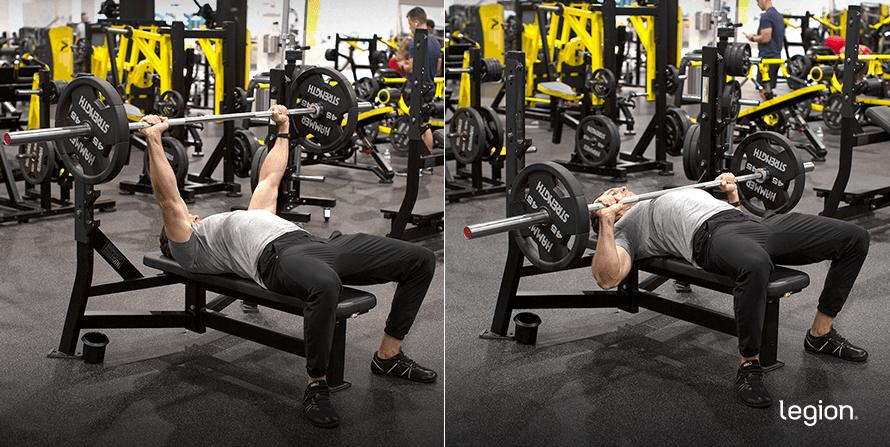
And here’s how the skullcrusher looks:
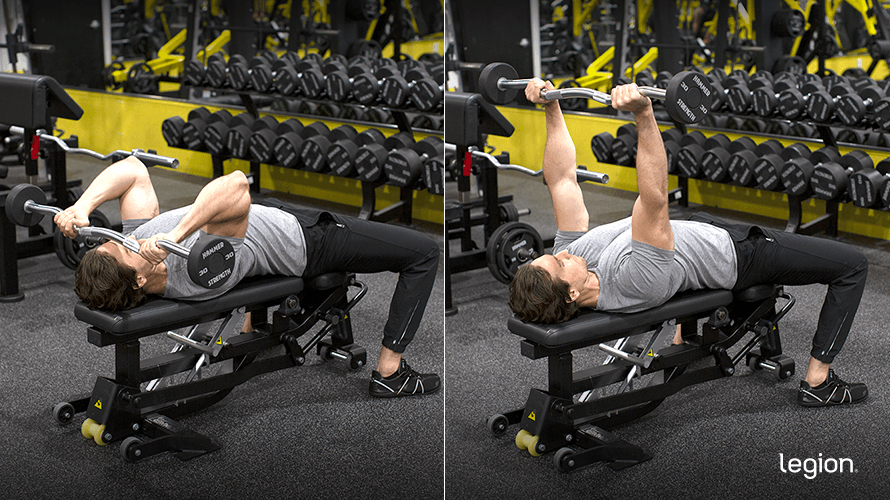
All the groups trained twice per week using 80% of their one-rep max and took every set to failure (the point at which they couldn’t complete a rep despite giving maximum effort). During the first 4 weeks, the weightlifters did 3 sets of their assigned exercise; for the following 3 weeks, they did 4 sets; and for the final 3 weeks, they did 5 sets.
The results showed that the groups that included the skullcrusher in their training experienced about twice as much overall triceps growth as the group that only did the bench press:
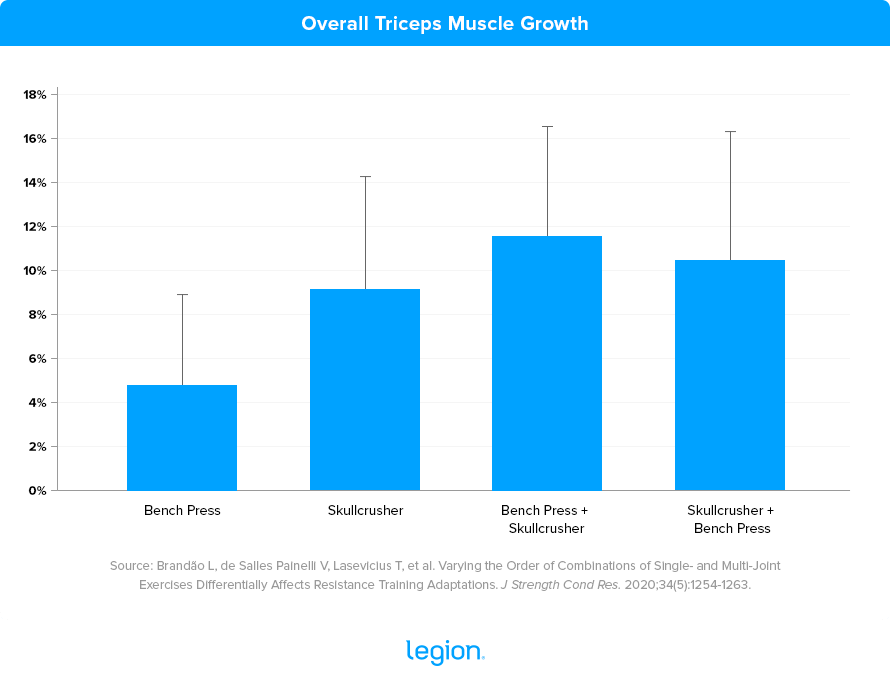
This doesn’t mean the bench press is terrible at training your triceps, though.
When you look more closely at the data, the bench press was significantly better than the skullcrusher at training the lateral head of the triceps:
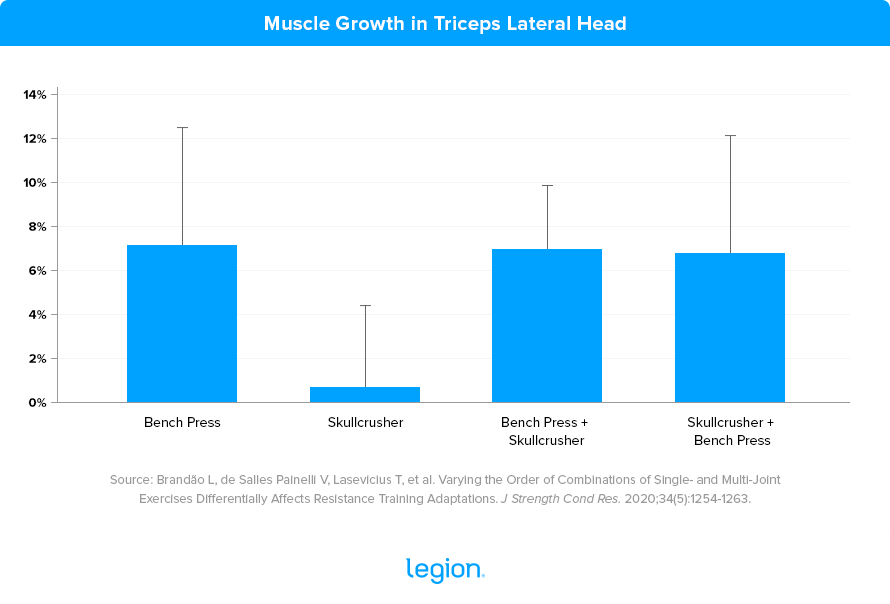
However, the groups doing the skullcrusher experienced significantly more growth in the long and medial heads of the triceps. The long and medial heads make up more of your upper-arm mass than the lateral head, which explains why the groups doing the skullcrusher saw better overall growth.
Here are the results for the long head:
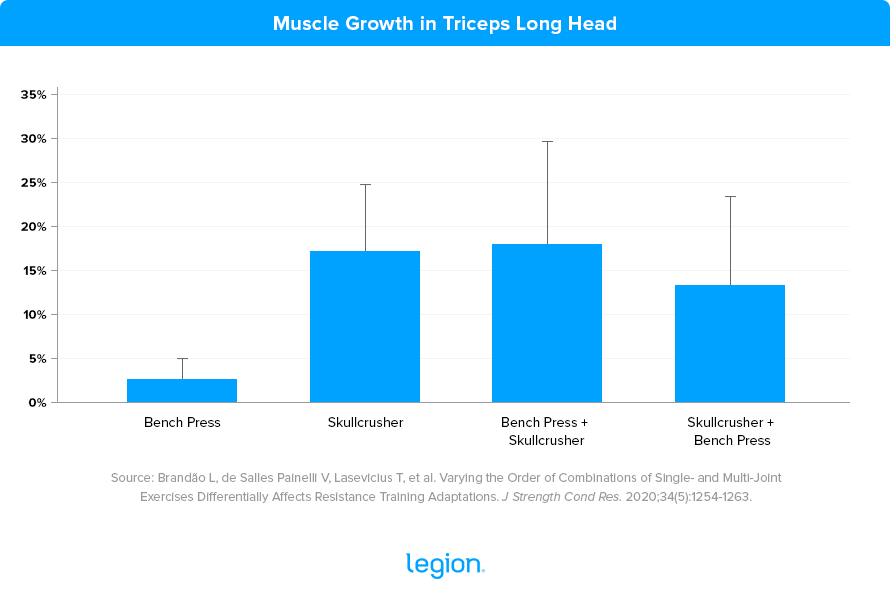
And here are the results for the medial head:
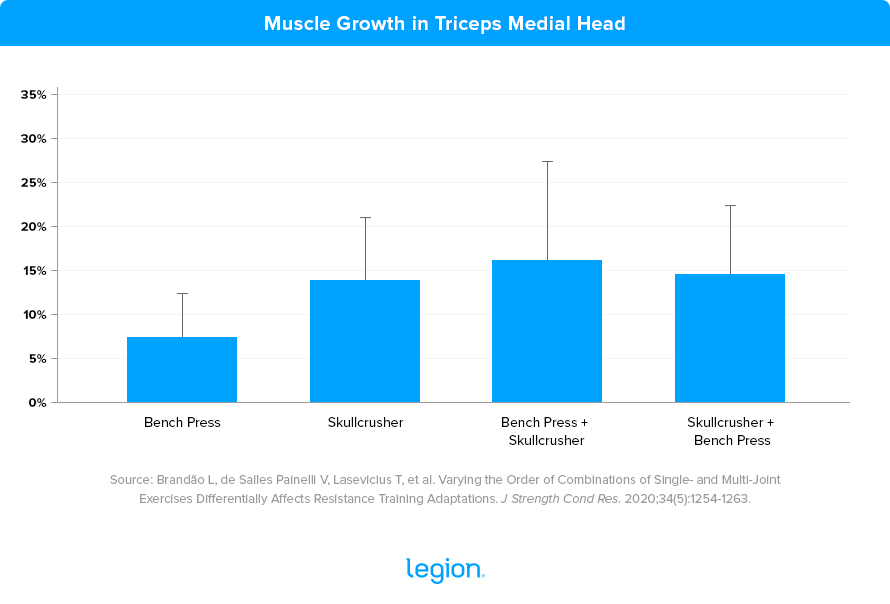
In other words, the results showed that the bench press is an effective exercise for training the lateral head of the triceps but probably isn’t enough to ensure well-rounded triceps development. For that, you’ll likely need an isolation exercise like the skullcrusher.
That said, there are a couple of caveats to consider.
First, the groups who did both the bench press and skullcrusher did double the total volume (sets and reps) throughout the study because they did two exercises per workout instead of just one.
Generally speaking, doing more volume leads to more growth. As such, the superior growth seen by the weightlifters doing both exercises may have been driven by the fact they did more sets and reps, not because there’s anything special about the skullcrusher.
Second, the researchers in this study asked the weightlifters to use a two-times shoulder-width grip for the bench press.
Research shows taking a grip this wide limits how much your triceps contribute to the lift. Therefore, the difference between the exercises may have been less pronounced (or non-existent) if the weightlifters had used a narrower grip.
Where does that leave us, then?
If both groups had done the same amount of volume and used a more typical grip width on the bench press, chances are the results would have been less striking. That is, both groups would have experienced more similar rates of overall growth.
I still think the groups doing both exercises would’ve gotten better results for two reasons:
- Similar studies show that adding isolation exercises to a program containing plenty of compound exercises leads to slightly more growth than doing compound exercises alone.
- Doing exercises that train your triceps in different ways—at different angles and through different ranges of motion—probably produces more balanced and complete growth than doing just 2 or 3 pressing exercises.
What’s the Best Way to Train Your Triceps?
The best way to train your triceps is to do 3-to-4 compound pressing exercises each week that allow you to handle heavy weights safely and progress regularly (both of which are vital for muscle and strength gain), then 1-to-2 triceps isolation exercises to round out your triceps development.
While you can use any exercises you like within this framework, making one of your compound exercises the close-grip bench press and one of your isolation exercises the overhead triceps extension is sensible.
The reason for this is the close-grip bench press emphasizes the triceps more than other bench press variations, making it the best bench press for triceps growth, and the overhead triceps extension places your triceps in a fully stretched position and trains them through a full range of motion, which is why it’s generally better for muscle growth than other similar exercises.
The most effective way to implement all of this into your program is to do two workouts per week that train your triceps: one push workout that you do early in the week and one upper-body workout that you do later in the week that emphasizes your arms.
This is the way I like to organize my own training and the approach I advocate in my fitness books for men and women, Bigger Leaner Stronger or Thinner Leaner Stronger.
Here’s an example of how the push workout might look:
- Flat Barbell Bench Press: 3 sets of 4-to-6 reps with 2-to-3 min rest
- Incline Barbell Bench Press: 3 sets of 4-to-6 reps with 2-to-3 min rest
- Dumbbell Bench Press: 3 sets of 6-to-8 reps with 2-to-3 min rest
- Overhead Triceps Extension: 3 sets of 6-to-8 reps with 2-to-3 min rest
And here’s an example upper-body workout that emphasizes your arms:
- Close-Grip Bench Press: 3 sets of 4-to-6 reps with 2-to-3 min rest
- Pull-up: 3 sets of 4-to-6 reps with 2-to-3 min rest
- Skullcrusher: 3 sets of 6-to-8 reps with 2-to-3 min rest
- Barbell Curl: 3 sets of 6-to-8 reps with 2-to-3 min rest
(And if you’d like even more specific advice about what exercises to include in your training program to reach your health and fitness goals, take the Legion Strength Training Quiz, and in less than a minute, you’ll know the perfect strength training program for you. Click here to check it out.)
Scientific References +
- Landin, D., Thompson, M., & Jackson, M. (2018). Functions of the Triceps Brachii in Humans: A Review. Journal of Clinical Medicine Research, 10(4), 290. https://doi.org/10.14740/JOCMR3340W
- Larsen, S., Gomo, O., & van den Tillaar, R. (2021). A Biomechanical Analysis of Wide, Medium, and Narrow Grip Width Effects on Kinematics, Horizontal Kinetics, and Muscle Activity on the Sticking Region in Recreationally Trained Males During 1-RM Bench Pressing. Frontiers in Sports and Active Living, 2. https://doi.org/10.3389/FSPOR.2020.637066
- de França, H. S., Branco, P. A. N., Guedes Junior, D. P., Gentil, P., Steele, J., & Teixeira, C. V. L. S. (2015). The effects of adding single-joint exercises to a multi-joint exercise resistance training program on upper body muscle strength and size in trained men. Applied Physiology, Nutrition, and Metabolism = Physiologie Appliquee, Nutrition et Metabolisme, 40(8), 822–826. https://doi.org/10.1139/APNM-2015-0109
- Gentil, P., Soares, S. R. S., Pereira, M. C., da Cunha, R. R., Martorelli, S. S., Martorelli, A. S., & Bottaro, M. (2013). Effect of adding single-joint exercises to a multi-joint exercise resistance-training program on strength and hypertrophy in untrained subjects. Applied Physiology, Nutrition, and Metabolism = Physiologie Appliquee, Nutrition et Metabolisme, 38(3), 341–344. https://doi.org/10.1139/APNM-2012-0176
- De Vasconcelos Costa, B. D., Kassiano, W., Nunes, J. P., Kunevaliki, G., Castro-E-Souza, P., Rodacki, A., Cyrino, L. T., Cyrino, E. S., & Fortes, L. D. S. (2021). Does Performing Different Resistance Exercises for the Same Muscle Group Induce Non-homogeneous Hypertrophy? International Journal of Sports Medicine, 42(9), 803–811. https://doi.org/10.1055/A-1308-3674
- Schoenfeld, B. J. (2010). The mechanisms of muscle hypertrophy and their application to resistance training. Journal of Strength and Conditioning Research, 24(10), 2857–2872. https://doi.org/10.1519/JSC.0B013E3181E840F3
- Barnett, C., Kippers, V., & Turner, P. (1995). Effects of variations of the bench press exercise on the EMG activity of five shoulder muscles. Journal of Strength and Conditioning Research, 9(4), 222–227. https://doi.org/10.1519/00124278-199511000-00003
- Oranchuk, D. J., Storey, A. G., Nelson, A. R., & Cronin, J. B. (2019). Isometric training and long-term adaptations: Effects of muscle length, intensity, and intent: A systematic review. Scandinavian Journal of Medicine & Science in Sports, 29(4), 484–503. https://doi.org/10.1111/SMS.13375
- Schoenfeld, B. J. (2010). The mechanisms of muscle hypertrophy and their application to resistance training. Journal of Strength and Conditioning Research, 24(10), 2857–2872. https://doi.org/10.1519/JSC.0B013E3181E840F3
- Mcmahon, G., Morse, C. I., Burden, A., Winwood, K., & Onambélé, G. L. (2014). Muscular adaptations and insulin-like growth factor-1 responses to resistance training are stretch-mediated. Muscle & Nerve, 49(1), 108–119. https://doi.org/10.1002/MUS.23884
- Maeo, S., Wu, Y., Huang, M., Sakurai, H., Kusagawa, Y., Sugiyama, T., Kanehisa, H., & Isaka, T. (2022). Triceps brachii hypertrophy is substantially greater after elbow extension training performed in the overhead versus neutral arm position. European Journal of Sport Science. https://doi.org/10.1080/17461391.2022.2100279










